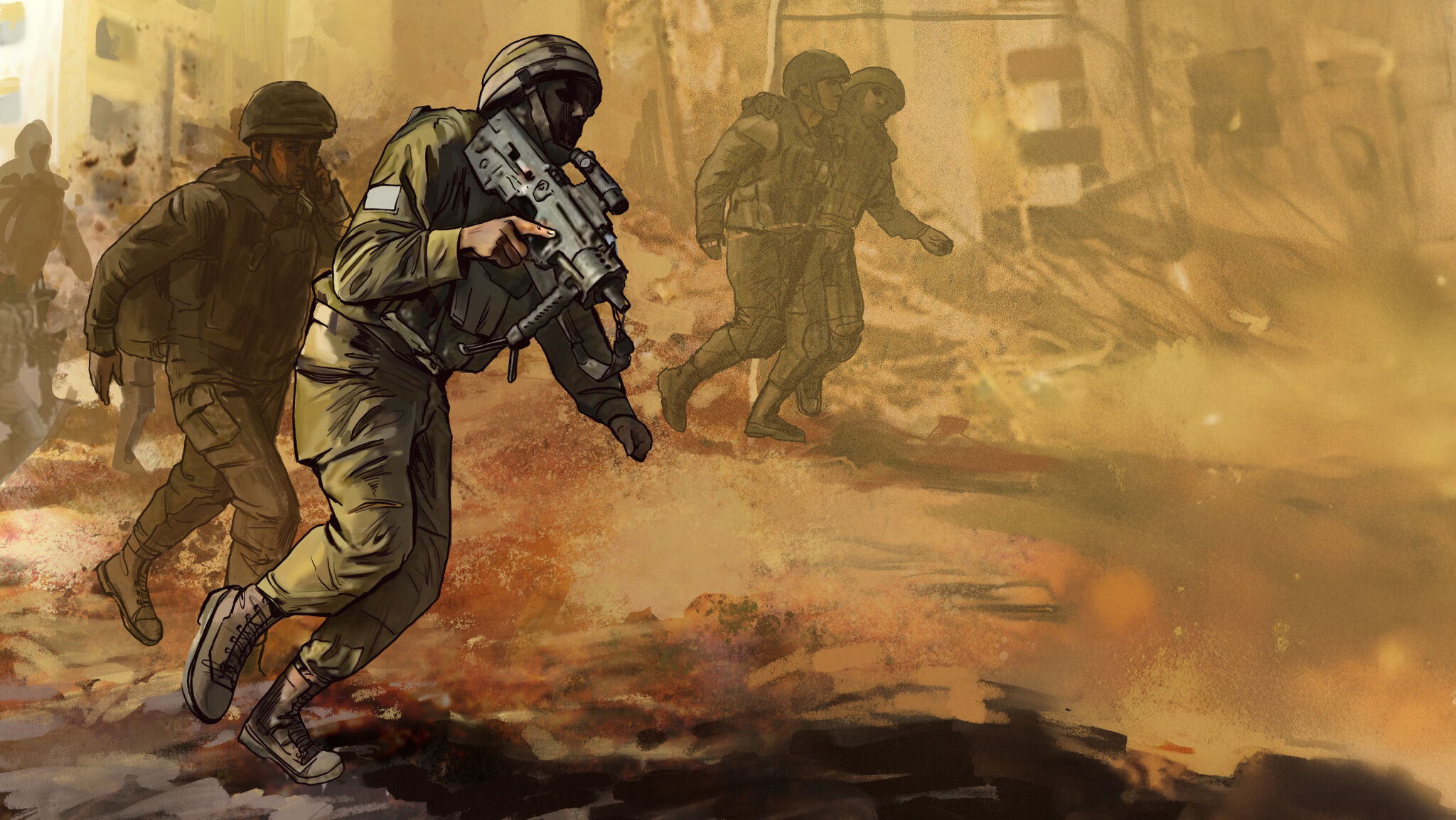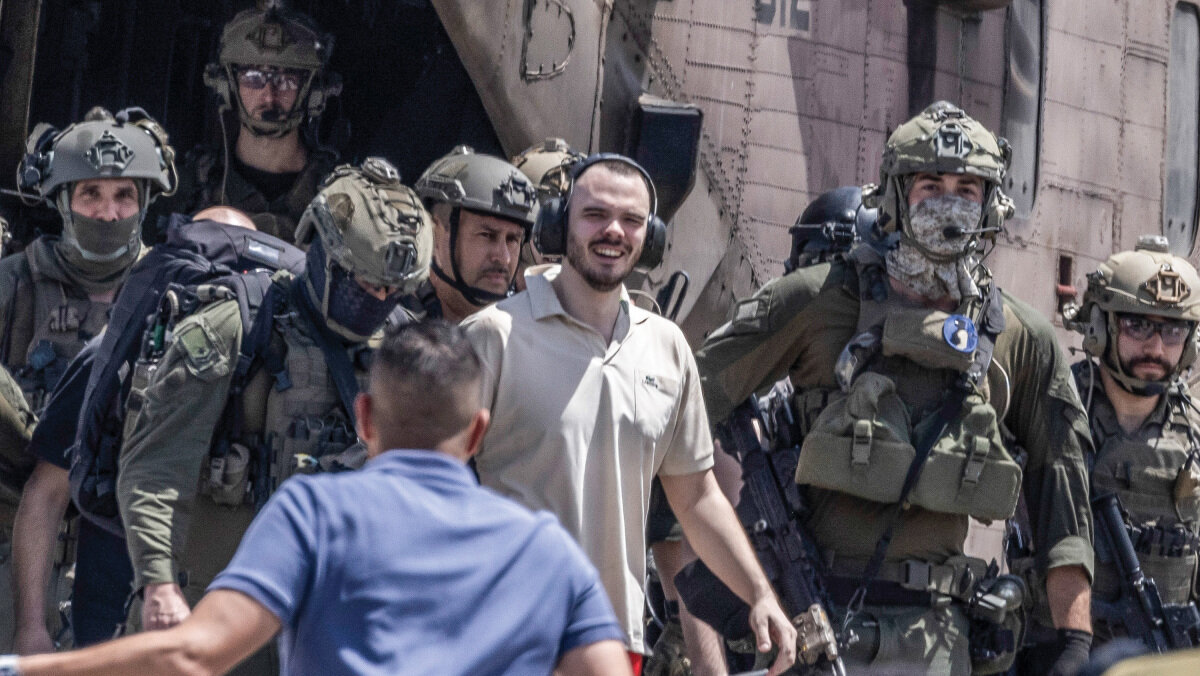‘The Diamonds Are in Our Hands’

‘The Diamonds Are in Our Hands’
A noticeably pregnant Palestinian woman walked on June 5, 2024, along a street in the Nuseirat Refugee Camp in the Gaza Strip. Wearing a hijab over her hair and a long black dress over her protruding stomach, she browsed vegetables from local vendors while complaining of the hardships of living in the war-torn region.
But this woman was not actually pregnant. Nor was she Palestinian.
She was an operative working with the Israel Defense Forces (idf). Fluent in Arabic with a perfect Gazan accent, she had meticulously disguised herself as a local woman. And what appeared to be grocery shopping was actually intelligence gathering for a top-secret mission.
This mission was necessary because eight months earlier—on the now infamous date of Oct. 7, 2023—thousands of Hamas terrorists and other Palestinians had carried out a satanic massacre against Israel. The Palestinians slaughtered 1,139 men, women and children, and kidnapped some 250 others.
Among the hostages were three men: 21-year-old Almog Meir Jan, 27-year-old Andrey Kozlov and 41-year-old Shlomi Ziv, as well as a 26-year-old woman, Noa Argamani. Noa became one of the most well known of the Israeli hostages after Hamas published a video of her being torn away from her boyfriend on October 7 and taken on a motorcycle between two terrorists. Her screams of despair and expression of horror were viewed by millions, making Noa the face of the Israeli hostages.
As the pregnant-looking woman was secretly gathering information, Noa and these three male hostages were in their 242nd day of captivity. They had been held in Gaza all that time, being transferred from one location to another in abysmal circumstances. They suffered from malnutrition and muscle atrophy, and were sometimes beaten and otherwise abused. And on June 5, they saw no end in sight for their captivity.
Little did they know that this Israeli woman was just outside the buildings they were imprisoned in and that events were in motion to attempt one of the most high-risk, complex and heroic rescue missions in recent military history.
‘Those Who Have Become Arab’
The location of Noa Argamani and the three men remained unknown to Israeli intelligence for months. But on May 12, 2024, Israel learned that they were being held somewhere in this particularly crowded part of the generally crowded Nuseirat Refugee Camp in the heart of the Gaza Strip.
Israeli leaders made a bold decision fraught with risks: Get in there and save them.
From that day on, agents in Tel Aviv were fixated on this part of the camp, watching and listening as best they could, 24 hours a day, 7 days a week. They needed to determine exactly which buildings the hostages were in, and even the precise floors and rooms, if possible. The Israelis also needed to determine the number of terrorists guarding each hostage, what kind of weaponry they were armed with, and every other piece of information that might be relevant to the mission. And they needed to know—and act—before something changed.
Only a small group of the highest-ranking officials in the War Cabinet, the Israel Defense Forces and the Shin Bet security service knew about the mission.
The Israelis used aerial observation and a range of other advanced technologies. But it wasn’t enough to zero in on the exact locations or figure out some of the other specifics. So Israeli leaders made the incredibly high-risk decision to get Israeli eyes directly at the location, undercover.
The name of the female agent who disguised herself as a pregnant Palestinian has not been disclosed. But it is clear she was part of a small unit of deep-cover Israeli Border Police troops, in Hebrew called Mista’arvim. This translates to “Those who have become Arab.”
The Mista’arvim had arrived around the start of June. They had arrived in this crammed camp in broad daylight, driving two old battered cars. Mattresses were tied to the roofs, dents marred the doors, and they were filled with undercover male and female agents and all kinds of household items—the kinds of items that most any displaced Gazan family would have had if they were relocating.
They stopped their cars and stepped out. This was the most dangerous place these Israelis could be. Hundreds of well-armed Hamas terrorists controlled everything around them, and even the civilians were largely aligned with the terrorists. These Israelis were now always a few minutes or seconds away from becoming victimized like their countrymen before them: captured, beaten, abused, battered, murdered.
The Mista’arvim agents said they were members of two Gazan families who had fled Rafah in the south of the Gaza Strip due to terrible shelling from the idf. They said they were searching for a residence in Nuseirat that they could rent. One of them produced a large bag of cash and offered to pay a price well above the going rate if they could be housed right away in this exact area.
The story sounded convincing and the cash was plenteous enough to quell suspicions. Within three hours, the undercover agents had moved into a house near the presumed location of the hostages.
They began right away to settle in and blend in to the area. They worked in two teams, making outings on foot down the dusty streets, browsing and sometimes buying what was for sale. They moved with total confidence, as if they were strolling down Ben Yehuda Street in Jerusalem, all the while secretly collecting whatever information they could, all the while at risk of capture and death.
Within a few days, the undercovers were able to zero in on a multistory building next to the al-Auda Medical Center as the location where Noa was being held. And they pinpointed another multistory residential building a half mile away where the three men were being held.
The agents used secure lines to pass the information along to their superiors. Twenty-eight commandos with Israel’s Yaman counterterrorism unit began using that information to rehearse for an even riskier operation: the rescue. They created elaborate models of this section of the Nuseirat camp. They walked through every step of the mission, trying to anticipate all that could go wrong and how they would surmount all resistance without hostage casualties.
These commandos would have liked more time to model and rehearse the operation. But the terrorists could relocate the hostages at any time, and the rescue opportunity would be history.
On June 6, the idf chief of staff, the War Cabinet and the head of Shin Bet determined they could delay no longer. That evening Prime Minister Benjamin Netanyahu gave the final approval, and other Israeli cabinet members and senior commanders were informed of the plan. With the help of United States and British intelligence, the rescue mission began.
‘It Was Actually Happening’
First the Israelis orchestrated an elaborate misdirection. This came in the form of two new idf military operations, one launched just east of Nuseirat in Bureij and the other southeast of the camp in east Deir al-Balah. These were designed to draw Hamas terrorists away from Nuseirat.
At the same time, most of the undercovers were instructed to quietly leave Nuseirat. Two agents remained in place to ensure that Israel would know if the hostages were relocated at the last minute.
Then on Saturday, June 8, shortly before 11 a.m., two furniture delivery trucks arrived near the al-Auda Medical Center. But rather than furniture, they carried 28 Yaman commandos.
Back in Tel Aviv, officers monitored live feeds of the two buildings and nearby streets. They assured the commandos that they still had the element of surprise, and at the very second the clock struck the hour, they gave the order: Now.
The two teams advanced on the targeted buildings at exactly the same moment to minimize the terrorists’ ability to react—especially by executing hostages.
The commandos rescuing Noa were able to quickly enter the building and eliminate the terrorists guarding her. One of them located the room she was held in and entered. “A soldier opened the door and said, ‘Hello Noa, this is the idf,’” she later told Israeli News 12. “I thought he was joking, so I didn’t move. Then he told me, ‘I’m going to pick you up over my shoulder, is that OK?’ That’s when I realized it was actually happening.”

By 11:06, the Yaman commandos had Noa safely out of the apartment and en route to a secure location. They soon placed her into an awaiting helicopter that transported her to the Sheba Medical Center near Tel Aviv.
Noa’s rescue went as smoothly as the Israelis could have hoped. But the situation with the three male hostages quickly became complicated.
Thanks to the reconnaissance work of the undercover agents, the Yaman commandos knew the three were being held in a certain room on the third flood of a residential building. A small number of them used a ladder to enter directly into that room.
At the same time, the larger part of this Yaman crew, led by 36-year-old Cmdr. Arnon Zamora, entered the building’s main door on the first floor. They immediately came under heavy fire from some 30 terrorists. This was far more than they were expecting. Zamora was hit.
The commandos who had entered the room by ladder got to the hostages and sheltered them inside a bathroom as hundreds of gunshots rang out below.
Commander Zamora’s men divided their attention between administering first aid to him and working to kill the terrorists who were firing on their positions. They were winning this extremely fraught battle, taking out the terrorists one after another. But everyone nearby could hear what was happening.
Many Hamas terrorists had left the area a day or two earlier due to the idf’s misdirection operations. But considerable numbers of them remained. They began rushing in from all directions, including from below through Gaza’s infamous tunnel systems.
Hell-bent on killing the Israelis, growing numbers of terrorists fired on them with pistols, automatic rifles and even rocket-propelled grenades.
The Israelis were able to evacuate their wounded commander and the hostages from the building. At 11:15, one of them spoke a phrase into the receiver of his encrypted phone that the officials in Tel Aviv had been aching to hear: “The diamonds are in our hands.”
After 245 days of captivity, all four of these “diamonds” were finally with their Israeli rescuers.
It was thrilling news—but the mission was still not complete. And the timeline had been thrown off by Zamora being wounded and the large number of terrorists joining the battle. The commandos’ planned exit route was crawling with terrorists and filled with gunfire and exploding grenades. They had to improvise.
With some carrying Zamora’s stretcher and others assisting the atrophied hostages, the commandos made their way through an alley and into a market area. By this indirect route and under heavy fire, they worked their way to their vehicle. But just before they arrived, it was struck by a pair of rocket-propelled grenades.
Back in Tel Aviv, authorities overseeing the mission saw that they had no choice but to activate “Plan B.” This meant bringing in several military divisions that had been on standby, awaiting orders. Tanks and more than a hundred soldiers from the Givati and Golani infantry brigades charged into the Nuseirat Camp, providing cover for the commandos. At the same time, Air Force helicopters flew in from the east, while warships in the Mediterranean provided additional cover fire from the west.
Involving land, sea and air assets in a rescue operation of this kind was highly unusual. But the reinforcements were able to isolate the battle scene and open up an escape corridor for the commandos and hostages.
After many terrorists had been eliminated, an idf helicopter landed just long enough to let the Israelis board. “When we got to the helicopter, I saw about 20 more soldiers,” Andrey Kozlov said in an interview with Israel Hayom. “They were so happy they had succeeded. They offered us Coke. I started crying, but after a few minutes, I started laughing.”
The helicopter took off toward the hospital, only a few minutes behind Noa Argamani.
“I’ll never forget the view from the helicopter window as we moved away and the Gaza Strip was visible from the back of the helicopter,” Kozlov said. “I waved goodbye, ‘Bye Gaza.’ I still can’t believe it.”
Inside the helicopter, attempts to revive chief inspector Arnon Zamora continued. But his wound was too severe. After landing, this 36-year-old husband and father of two was pronounced dead.
During the weeks of meticulous intelligence gathering, planning and rehearsing, the Israelis had called the mission Operation Seeds of Summer. But Arnon Zamora willingly risked his life to stand uncompromisingly against evil and to free his countrymen. And he lost his life in that noble stand. So a short time after his death, the mission was renamed Operation Arnon.
‘They Do Not Compromise With Evil’
“Arnon Zamora … and his heroic friends straightened the back of the nation,” Netanyahu said after the operation. “This is a heroic operation, which will be written down in the history of military operations, in the history of the heroism of the Israeli people.”
Netanyahu and others compared the mission to the famous 1976 idf operation in which troops flew 3,000 miles to launch a surprise raid and rescue a group of airplane hostages, defying enormous logistical and tactical odds. That mission is known as Operation Yonatan, after the only Israeli killed in the action: Cmdr. Yonatan Netanyahu.
At that time, the late educator Herbert W. Armstrong said Israel “showed the rest of the world an example of how to deal with this international menace” of terrorism, and provided “an example of daring, courage and efficient execution in a lightning military operation” (Plain Truth, September 1976).
Mr. Armstrong said the idf rescuers taught a “supremely important truth” about the dangers of compromising with evil. “Sometimes, whether in terrorist skyjackings or handling the Word of God, temptations tend to sweep us off our feet,” he wrote. “[I]f we begin to compromise with God’s truth, even in smallest, slightest manner,” it can lead to destruction. “There is a striking parallel in the recent skyjacking” at Entebbe, he wrote (Good News, December 1976).
Mr. Armstrong’s understanding of the dangers of compromise was rooted in the instruction of the Bible. “Joyful are people of integrity …. They do not compromise with evil, and they walk only in his paths” (Psalm 119:1, 3; New Living Translation).
The comparisons between Operation Yonatan and Operation Arnon are entirely valid. And we can be inspired by the courage, sacrifice and refusal to compromise with evil that made it such a success. Each of us could benefit from following the example of Arnon and the others who risked their lives, becoming individuals of joyful integrity, boundless courage and moving self-sacrifice.

